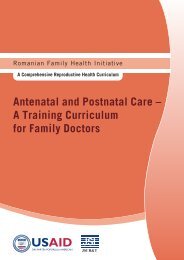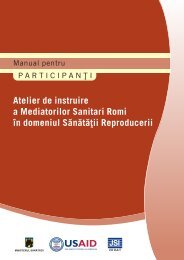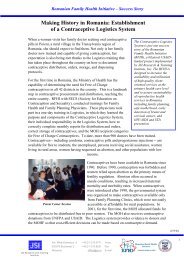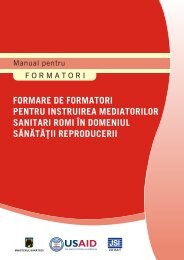Training of Roma Health Mediators in Reproductive Health
Training of Roma Health Mediators in Reproductive Health
Training of Roma Health Mediators in Reproductive Health
Create successful ePaper yourself
Turn your PDF publications into a flip-book with our unique Google optimized e-Paper software.
• After stopp<strong>in</strong>g the <strong>in</strong>jection, it usually takes 6-10 months to become pregnant<br />
(reversibility <strong>of</strong> the method is delayed).<br />
• Because <strong>of</strong> these side-effects some women give up us<strong>in</strong>g <strong>in</strong>jectable contraceptives<br />
which are one <strong>of</strong> the most effective methods <strong>of</strong> family plann<strong>in</strong>g. Emphasize that<br />
these side effects are not signs <strong>of</strong> sickness.<br />
• There are also some situations or conditions <strong>in</strong> which women should not use the<br />
method. Thus, it is necessary for women to seek the services <strong>of</strong> a tra<strong>in</strong>ed health<br />
provider (such as a Family Doctor) if they are <strong>in</strong>terested <strong>in</strong> us<strong>in</strong>g <strong>in</strong>jectable<br />
contraceptives.<br />
[Note: A pre-prepared flipchart may be used to expla<strong>in</strong> the method].<br />
d) INTRA-UTERINE DEVICE (IUD) (20 m<strong>in</strong>utes)<br />
Expla<strong>in</strong> that usually <strong>in</strong> rural communities, the health providers (family doctors) distribute<br />
only condoms, pills and <strong>in</strong>jectables. Other long-term family plann<strong>in</strong>g methods are<br />
available <strong>in</strong> Family Plann<strong>in</strong>g cl<strong>in</strong>ics, hospitals and private cl<strong>in</strong>ics, and they must be<br />
promoted.<br />
Ask the group to name the methods for which women must be referred to a cl<strong>in</strong>ic, health<br />
center or hospital. List them on the flipchart<br />
• IUDs<br />
• Voluntary surgical contraception<br />
- Vasectomy<br />
- Tubal ligation<br />
Show packets <strong>of</strong> IUDs to the participants. Let them see how small the IUD is <strong>in</strong><br />
comparison to the uter<strong>in</strong>e cavity <strong>of</strong> the women where it is placed.<br />
Expla<strong>in</strong> that:<br />
• An IUD is a small plastic device (which may conta<strong>in</strong> copper or progesterone<br />
hormone) that is placed <strong>in</strong> the uterus <strong>of</strong> a non-pregnant woman where it acts as an<br />
effective long-term but reversible contraceptive.<br />
• The most commonly used IUD is a Copper T. The Copper T looks like the letter<br />
“T. The stem <strong>of</strong> “T” is wound with copper wire. Two th<strong>in</strong> nylon threads are<br />
attached to its lower end and lie <strong>in</strong> the vag<strong>in</strong>a. The threads are very important for<br />
a woman us<strong>in</strong>g an IUD: they allow her to check after each menstrual period to<br />
verify that the IUD is still <strong>in</strong> place, and they allow a medical doctor to remove the<br />
IUD from the uterus when necessary.<br />
Briefly expla<strong>in</strong> the method us<strong>in</strong>g the tra<strong>in</strong>er document Intra-Uter<strong>in</strong>e Device<br />
(presentation) as a basis.<br />
[Note: A pre-prepared flipchart may be used to expla<strong>in</strong> the method].<br />
Expla<strong>in</strong> that Family Doctors usually know where to refer women for IUD <strong>in</strong>sertion.<br />
50<br />
RFHI/JSI <strong>Roma</strong>nia <strong>Tra<strong>in</strong><strong>in</strong>g</strong> <strong>of</strong> RHMs <strong>in</strong> <strong>Reproductive</strong> <strong>Health</strong> Session 4: FP Methods








